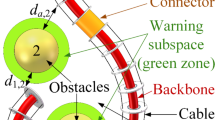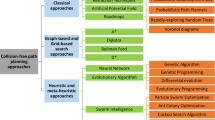Abstract
This paper presents a new Center of Gravity (COG) trajectory planning algorithm for a quadruped robot with redundant Degrees of Freedom (DOFs). Each leg has 7 DOFs, which allow the robot to exploit its kinematic redundancy for various locomotion and manipulation tasks. Also, the robot can suitably adapt to different environment (e.g., passing through a narrow gap) by simply changing the body posture. However, the robot has significant COG movement during the leg swinging phase due to the heavy leg weights; the weight of all the four legs takes up 80% of the robot’s total weight. To achieve stable walking in the presence of undesired COG movements, a new COG trajectory planning algorithm was proposed by using a combined Jacobian of COG and centroid of a support polygon including a foot contact constraint. Additionally, the inverse kinematics of each leg was solved by modified improved Jacobian pseudoinverse (mIJP) algorithm. The mIJP algorithm could generate desired trajectories for the joints even when the robot’s leg is in a singular posture. Owing to these proposed methods, the robot was able to perform various modes of locomotion both in simulations and experiments with improved stability.
Similar content being viewed by others
References
Chiaverini S, Oriolo G, Walker I D. Kinematically redundant manipulators. In: Siciliano B, Khatib O, eds., Handbook of Robotics, Springer, Berlin-Heidelberg, Germany, 2008, 245–268.
Omrčen D, Žlajpah L, Nemec B. Compensation of velocity and/or acceleration joint saturation applied to redundant manipulator. Robotics and Autonomous Systems, 2007, 55, 337–344.
Zhao Y J, Jin L, Zhang P, Li J Y. Inverse displacement analysis of a hyper-redundant elephant’s trunk robot. Journal of Bionic Engineering, 2018, 15, 397–407.
Kwak B, Park H, Bae J. Development of a quadruped robot with redundant DOFs for high-degree of functionality and adaptation. Proceedings of IEEE International Conference on Advanced Intelligent Mechatronics (AIM), Banff, Canada, 2016, 608–613.
Shkolnik A, Tedrake R. Inverse kinematics for a point-foot quadruped robot with dynamic redundancy resolution. Proceedings of IEEE International Conference on Robotics and Automation (ICRA), Rome, Italy, 2007, 4331–4336.
Byl K, Byl M, Satzinger B. Algorithmic optimization of inverse kinematics tables for high degree-of-freedom limbs. Proceedings of ASME Dynamic Systems and Control Conference (DSCC), San Antonio, USA, 2014.
Byl K, Byl M. Design of fast walking with one-versus two-at-a-time swing leg motions for RoboSimian. Proceedings of IEEE International Conference on Technologies for Practical Robot Applications (TePRA), Woburn, USA, 2015, 1–7.
Chan T F, Dubey R V. A weighted least-norm solution based scheme for avoiding joint limits for redundant joint manipulators. IEEE Transactions on Robotics and Automation, 1995, 11, 286–292.
Sciavicco L, Siciliano B. A solution algorithm to the inverse kinematic problem for redundant manipulators. IEEE Journal on Robotics and Automation, 1988, 4, 403–410.
Siciliano B, Slotine J-J E. A general framework for managing multiple tasks in highly redundant robotic systems. Proceedings of International Conference on Advanced Robotics, Pisa, Italy, 1991, 1211–1216.
Cheng F T, Lee H L, Orin D E. Increasing the locomotive stability margin of multilegged vehicles. Proceedings of IEEE International Conference on Robotics and Automation (ICRA), Detroit, USA, 1999, 1708–1714.
Pongas D, Mistry M, Schaal S. A robust quadruped walking gait for traversing rough terrain. Proceedings of IEEE International Conference on Robotics and Automation (ICRA), Roma, Italy, 2007, 1474–1479.
Zhang S S, Rong X W, Li Y B, Li B. A composite cog trajectory planning method for the quadruped robot walking on rough terrain. International Journal of Control and Automation, 2015, 8, 101–118.
ROBOTIS Dynamixel, [2018-03-13], http://www.robotis.com/.
SMOOTH-ON Dragon skin, [2018-03-13], https://www.smooth-on.com/product-line/dragon-skin/.
He J, Gao F. Type synthesis for bionic quadruped walking robots. Journal of Bionic Engineering, 2015, 12, 527–538.
Gonzalez-Rodriguez A G, Gonzalez-Rodriguez A, Castillo- Garcia F. Improving the energy efficiency and speed of walking robots. Mechatronics, 2014, 24, 476–488.
Whitney D E. Resolved motion rate control of manipulators and human prostheses. IEEE Transactions on Man-machine Systems, 1969, 10, 47–53.
Siciliano B, Sciavicco L, Villani L, Oriolo G. Robotics: Modeling, Planning and Control, Springer, London, UK, 2009.
Zghal H, Dubey R V, Euler J A. Efficient gradient projection optimization for manipulators with multiple degrees of redundancy. Proceedings of IEEE International Conference on Robotics and Automation (ICRA), Cincinnati, USA, 1990, 1006–1011.
MathWorks MATLAB, [2018-03-01], https://www.mathworks.com/.
McGhee R B, Frank A A. On the stability properties of quadruped creeping gaits. Mathematical Biosciences, 1968, 3, 331–351.
Coppelia Robotics V-REP, [2018-03-01], http://www.coppeliarobotics.com/.
Song S M, Waldron K J. An analytical approach for gait study and its applications on wave gaits. The International Journal of Robotics Research, 1987, 6, 60–71.
Hirose S, Tsukagoshi H, Yoneda K. Normalized energy stability margin and its contour of walking vehicles on rough terrain. Proceedings of IEEE International Conference on Robotics and Automation (ICRA), Seoul, Korea, 2001, 181–186.
Vukobratović M, Borovac B. Zero-moment point — thirty five years of its life. International Journal of Humanoid Robotics, 2004, 1, 157–173.
Messuri D A, Klein C A. Automatic body regulation for maintaining stability of a legged vehicle during rough-terrain locomotion. IEEE Journal on Robotics and Automation, 1985, 1, 132–141.
Acknowledgment
This work was supported by the 2018 Research Fund (1.180015.01) of UNIST (Ulsan National Institute of Science and Technology), the Basic Science Research Program through the National Research Foundation of Korea (NRF) funded by the Ministry of Science and ICT (No. NRF-2015R1C1A1A01053763), and the NRF Grant funded by the Korean Government (MSIT) (No. NRF-2016R1A5A1938472).
Author information
Authors and Affiliations
Corresponding author
Rights and permissions
About this article
Cite this article
Park, H., Kwak, B. & Bae, J. Inverse Kinematics Analysis and COG Trajectory Planning Algorithms for Stable Walking of a Quadruped Robot with Redundant DOFs. J Bionic Eng 15, 610–622 (2018). https://doi.org/10.1007/s42235-018-0050-8
Published:
Issue Date:
DOI: https://doi.org/10.1007/s42235-018-0050-8




